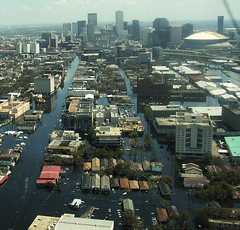 Despite rumors and media reports at the time, new research claims that Hurricane Katrina did not spawn waves of crime in other cities. As USA Today reports:
Despite rumors and media reports at the time, new research claims that Hurricane Katrina did not spawn waves of crime in other cities. As USA Today reports:
In the current Journal of Criminal Justice study led by sociologist Sean Varano of Roger Williams University in Bristol, R.I., the authors look at statistics for robbery, rape, murder, car theft and other violent crimes in Houston, San Antonio and Phoenix before and after Katrina evacuees arrived in those cities. The 2005 storm, which killed about 1,800 people and caused more than $80 billion in damages, according to the National Hurricane Center, led to the relocation of more than one million people…
The study found a slight rise in murder and robbery in Houston, when adjusted for the long-term crime patterns, but no increase in other crimes (and suggested drops in rape and aggravated assaults); no effect at all in San Antonio; and another slight statistical rise in the murder rate in Phoenix. “Any increase in murder is intolerable,” Varano says, but a lack of increase in crimes such as car theft and robbery, where economic motives most clearly would tempt so many displaced people, argues against a crime wave driven by evacuees, he says.
Meanwhile, “Many communities across the United States … also reported increases in violent crime between 2004 and 2006,” notes the study, including a 30% increase in aggravated assault in cities such as Baltimore and Detroit.
The belief that rises in crime and disorder arise from disasters like Katrina is nothing new.
A crime wave spawned by evacuees is typical of “disaster myths” seen after catastrophes, such as the mythical Superdome riots reported in the days after the hurricane, says disaster management scholar Joseph Trainor of the University of Delaware, who was not part of the study. “This is a very strong study showing long-term effects and (showing) people’s resiliency after a disaster.”
Disasters such as Hurricane Katrina and the Jan. 12 earthquake in Haiti almost always spawn fears of riots or criminality, seen in some early reports from Port-Au-Prince. But on Jan. 18, U.S. Navy Rear Admiral Mike Rogers, Director of Intelligence for the Joint Staff, told a news conference, “we have seen nothing that suggests to us that we have widespread disorder; no sense of widespread panic.”
“Fifty years of social science show people are not victims of disasters, they are survivors,” Trainor says. “People are adaptive and altruistic, mass rioting and mass looting are just disaster myths for the most part.”
The take home message?
“One lesson is that after disasters we have to think about where evacuees land, and not just the disaster site itself,” Varano says. He argues that crime rate changes after displaced people arrive in a city like Houston or Phoenix tells us more about the conditions at the arrival location than about the displaced people themselves. Strong communities undoubtedly handle influxes of evacuees better than already weak ones, he says.
“Another is that public officials, and news organizations, have a responsibility to speak very carefully about the reality of disaster situations,” Varano concludes. “There’s a danger of host cities not wanting to accept people in desperate straits because of false perceptions.”

Comments